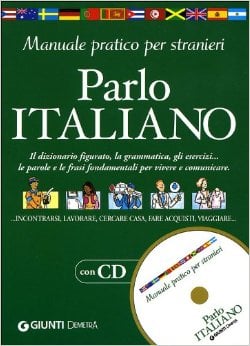The first and most important thing to know about Parlo Italiano is that it’s all in Italian. From the introduction to the lessons to the appendix, every last word is in Italian. Although the subject matter and layout is obviously for lower levels, it’s also for those who aren’t afraid to dive in headfirst. In fact, the introduction states that this book is for those who are moving to or are already in Italy and know a bit of the language.
All ten units are set up the same way, and include dialogues, vocabulary and grammar sections. Each unit tackles everyday situations through conversation and vocabulary, starting with introducing oneself and moving on to jobs, the house, free time, dining out, at the doctor and more. Each unit is vocabulary-heavy, and there are tons of cartoonish pictures next to the new terms, which is great for visual learners. Each page is filled to the brim, but verb tenses tend to be boxed off and each exercise is visually contained so students will not get too overstimulated.

Students can listen to the dialogues on the accompanying CD. After every dialogue, there is a comprehension exercise, which is usually filling in a chart or a gap fill. After each grammar point, there is also a short exercise, but this book could benefit from more than one exercise per activity.
There is an imbalance between the amount of vocabulary and exercises. One of the problems with the vocabulary is simply that it’s dated -- there’s barely any reason to teach students the word for “cassette” anymore. Beyond that, there’s also the sheer amount. Teaching car parts or parts of the stereo are less likely to be retained by students since there is likely to be less of a chance to use these words. Teachers, or students who are self-teaching, may want to pick and choose what vocabulary to teach. Or they can skim over all of it for ease of understanding the following exercises, but can then only concentrate and review more pertinent words as the units and course goes on.
Another imbalance is the amount of exercises. There is just one exercise after each listening or grammar section, and overall, this is definitely lacking in the book. At the back, students can check answers and review verb tenses and irregular verbs, but there are no additional exercises. Teachers would be wise to come into class armed with lots of extras. That being said, the generous amount of dialogues can easily be molded into other activities. Students can simply listen, act it out, read it again and again with the teacher blocking out more and more words each time until students are reciting it by memory, and more.
Although the subject matter and layout is obviously for lower levels, it’s also for those who aren’t afraid to dive in headfirst. In fact, the introduction states that this book is for those who are moving to or are already in Italy and know a bit of the language.
The dialogues eventually do get longer and incorporate grammar and vocabulary from previous units, so it’s a nice way to retain some previous knowledge. There are also short reading sections in addition to the dialogues. Additionally, each unit contains social phrases that relate to the vocabulary at hand, although these are rarely incorporated into the rest of the book, so teachers should be aware that these will need extra attention if s/he chooses to focus on them.
One cool, unexpected gem at the back is some information about the holidays in Italy as well as a brief overview of the governmental branches and a map showing the regions and provinces of the country. Although it kind of seems like a one-off, teachers can turn that into a full lesson with some supplementary materials or self-study students can use that as a base to further study the political, physical and historical landscape of Italy.
Whether using this in class or for self-study, it’s necessary to have another, preferably more exercise- or grammar-based, book alongside Parlo Italiano. While this book does an excellent job with vocabulary and getting students to hone their listening skills, it lacks the exercises that students need for repetition purposes. Teachers should also have several exercises or extensions ready in case there is extra class time or students remain confused on a certain point.
Overall, the book is very strong in regards to vocabulary and listening, and with the right accompanying materials, it could be an vital resource. For those who are self-studying, the same ideal holds: if they can find a few extra resources, they will be much better off in learning Italian quickly.




